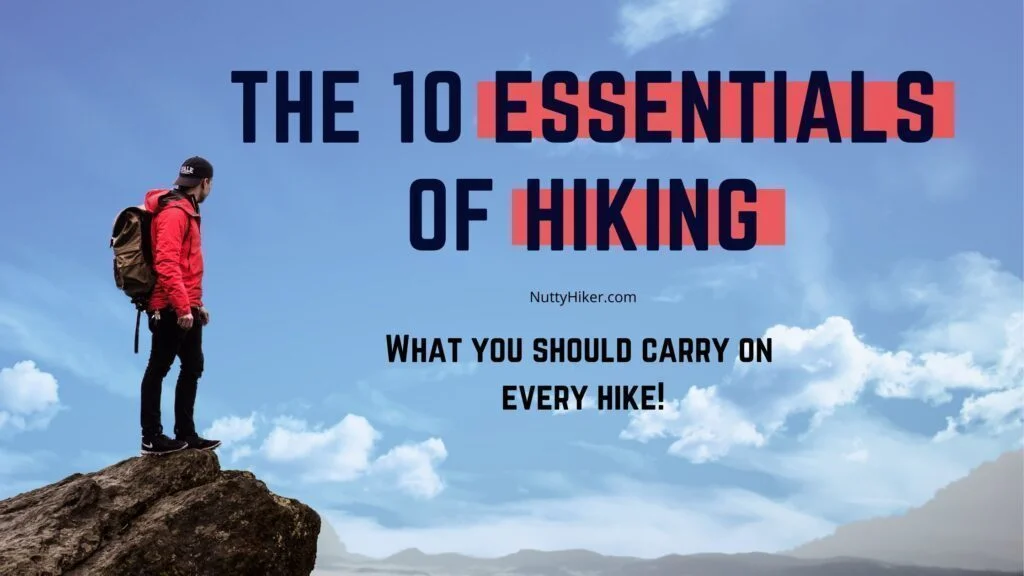What are the 10 Essentials of Hiking, you ask. The 10 essentials of hiking are the items you should bring with you on every single hike. They are a collection of items that can help you in the event of an emergency, sudden weather changes, or unexpected delays such as getting lost or turned around.
The 10 essentials have changed over the years since they were first debuted in 1974 in the third edition of “Mountaineering: The Freedom of the Hills.” While it had its first public appearance in 1974, it was originally put together by The Mountaineers during the 1930s to help people be prepared for emergency situations in the great outdoors!

The 10 Essentials of Hiking
Now known as the Freedom 9 system; instead of specific items (seen below under the Original 10 Essentials) they use more of a category system.
1. Navigation
Map, compass, altimeter, GPS device, and PLB or satellite communicators. These will be used to plan your route OR help you find your way back to your route in the event you wander off track (which happens more than you think). I personally ALWAYS a Garmin inReach Explorer+ which is a GPS and satellite communicator in one; which eliminates carrying a GPS and PLB. It may seem redundant to carry all of this, but you will be glad to have a backup if your primary navigation system fails.
2. Headlamp (Illumination)
Headlamp or small flashlight. You will want some kind of light to help you find your way around in the event you are out after dark. I prefer using a headlamp as it allows me to keep my hands free. Make sure that you also pack extra batteries (or a battery brick if the headlamp is the rechargeable kind).
3. Sun protection
Sunglasses, sun hats, sun-protective clothing, trekking umbrella, and sunscreen all fall into this category. You will want to protect your skin and eyes against harsh UV rays that are responsible for sunburns (yes you can damage (burn) your eyes). Sunburns can also lead to quicker dehydration, which can then lead to heat exhaustion which then leads to heatstroke.
4. First aid
Including foot care and insect repellent (if required). Don’t skimp on this. Many backpackers will tell you to bring only a bandaid and a small tube of antibiotic ointment. That won’t help you in the event of an emergency. You can start with a pre-made kit and modify it to fit your trip and needs. I personally have one first aid kit that I use no matter the trip. I just find it easier. Yes, it means I may carry a little more, but I am okay with that. However, you should go through it regularly to check for expired items and replace them as needed. You can check out my backpacking first aid kit here.
5. Knife (& Repair Kit)
You will want to carry a knife and a basic repair kit that has duct tape, a needle, scissors, and dental floss (I prefer it over thread). Opt for a multi-tool such as a swiss army knife.
6. Fire
Matches (waterproof), lighter, tinder, or stove as appropriate. You will want to carry a way to start a fire in the event you get caught out there longer than expected. Fire is used as a way to signal an emergency, keep warm, cook food, and can help keep predators away. Make sure to always check local fire regulations before heading out.
7. Shelter
This is one of the most important elements during an emergency survival situation as it can protect you from weather and exposure. You should always carry some sort of shelter with you, even if it is a light emergency bivy; but it could be a tent, emergency blanket, emergency bivy, or tarp.
8. Extra food
Always carry beyond the minimum expectation. Basically, carry an extra day’s worth. If you plan on 2 days, bring 3 days. Try to pack items that are a good nutritional value in order to keep your energy up. Trail mix, nuts, Cliff Bars, etc… work really well.
9. Extra water
Carry more water than you think you need. Also carry some way to purify water whether it is purification tabs, filter, or a way to boil water. That way, in the event you do run out and can find a water source, you are still able to get potable water. Always plan ahead and familiarize yourself with any water sources in the area you will be (lake, stream, river, etc…). I suggest bringing electrolytes as well.
10. Extra clothes
Beyond what you expect to wear. You need to be prepared for sudden weather changes. For instance, during the cooler months (Spring, Fall & Winter) I will always pack a puffy, rain gear, gloves, beanie, and base layer. For warmer months, I pack rain gear and a base layer. It just really all depends on the area you are in, what kind of weather can be expected that time of year, and your tolerance to unexpected weather changes. You want to pack an extra layer for whatever the most extreme weather you can expect for that time of year will be.
The Original 10 Essentials
This is the classic original 10 Essentials list. It has changed over the years to what they call the Freedom 9 system (which is listed above).
- Map
- Compass
- Sunglasses and sunscreen
- Extra clothing
- Headlamp or flashlight
- First-aid supplies
- Firestarter
- Matches
- Knife
- Extra food
Free Packing List Download
Download your free packing list of what you should carry on every hike. While not required to download, I would really appreciate a follow if you’d like to show your support!

Disclaimer: These articles are here to serve others as a guide on their own outdoor & travel adventures. You use any advice given on this site at your own risk. Exploring & Hiking Hiking can be risky activities; fatalities and injuries do occur. You assume responsibility when you decide to visit or hike in a particular location. Not all trails, attractions, and travels are safe for everyone. What works for me, may not work for you. Do your own research on gear and destinations before proceeding. Information is accurate at the time of posting and is subject to change at any time.




This site is really a stroll-by for all of the information you needed about this and didn’t know who to ask.